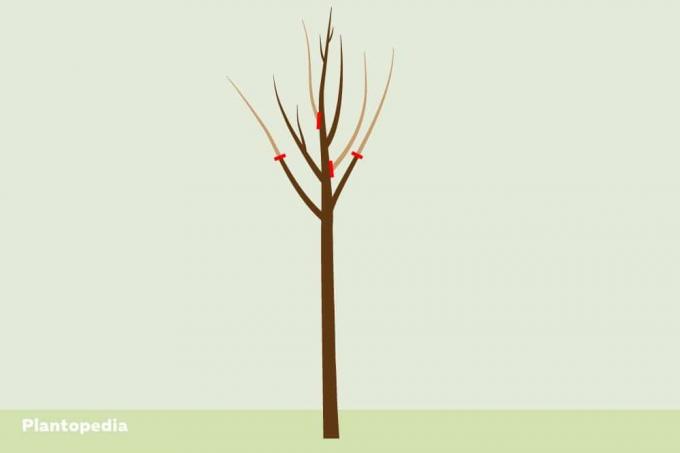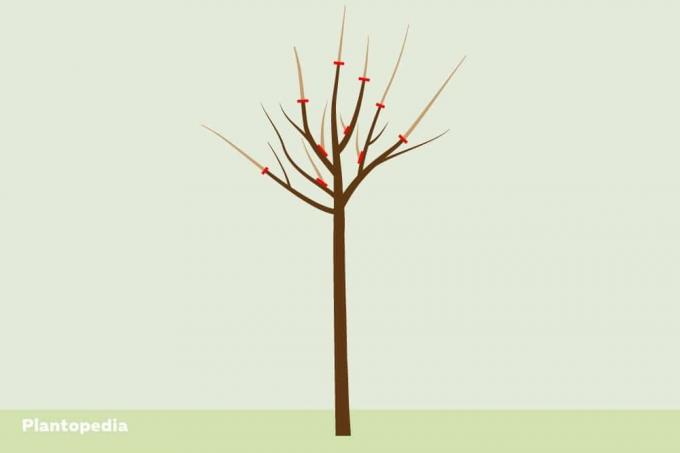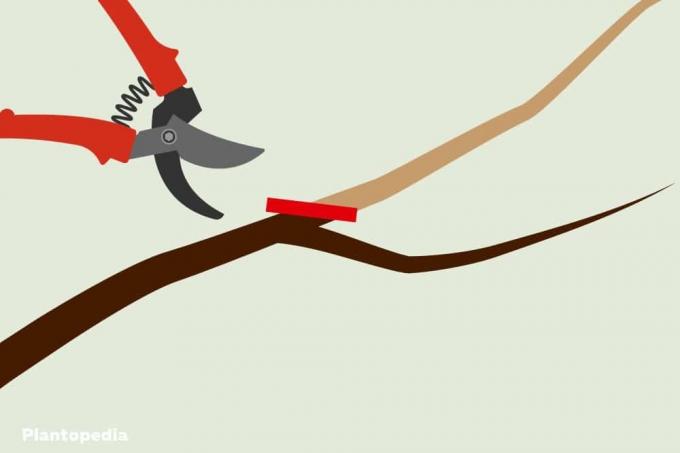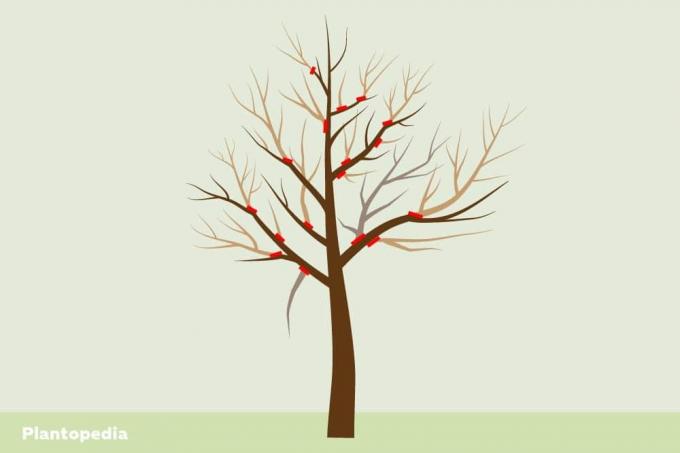
table of contents
- The right time
- Required cutting tool
- Cutting measures according to age groups
- Plant pruning
- Upbringing
- Conservation cut
- Derive fruit wood
- Summer cut
- Taper cut
The cultivated apple (Malus domestica) forms its leaves mainly on the annual shoots. These ensure that the apple tree receives sufficient energy and can thus produce a rich harvest. From the second year onwards, flower buds develop on these shoots. This knowledge forms the basis of the annual cutting measures. If all annual shoots are removed, the harvest will also be less. The targeted cutting of selected branches is therefore of great importance.
The right time
When to prune an apple tree depends on several factors. Pruning measures that take place during the winter months allow a good overview of the existing branches thanks to the lack of leaves. Most apple trees can withstand winter pruning down to temperatures of minus five degrees without any problems. When the new growing season begins, the apple tree can devote all of its energy to developing new shoots. The winter pruning serves to stimulate growth, while a summer pruning slows the growth rate. Since the tree loses a large part of its photosynthetic surface, shaping cuts are sufficient for the summer. Of the
time depends on these factors:
- Hibernation: between January and April the tree can withstand pruning
- Frost: choose a day when there is no risk of frost
- Growth spurts: summer shaped cuts as soon as saplings appear
- Breeding season: For conservation reasons, do not cut when birds are breeding in the crown
Required cutting tool
When pruning an apple tree, it is important that the blades leave a smooth cut. This means that pathogens or fungal spores cannot enter the wood. To prevent infection, the blades should be cleaned thoroughly and disinfected before any action. Which tool you use depends on the branch thickness:
- Cut off shoots up to two centimeters in diameter with secateurs
- Cut branches up to four centimeters thick with pruning shears
- Use a saw to cut branches that are more than four centimeters in diameter

The older the tree gets, the more splendid and taller its crown develops. A stable folding ladder is therefore part of the basic equipment of every hobby gardener. With telescopic pruning shears you can prune branches up to a height of four meters.
Cutting measures according to age groups
In the first years of growth, regular pruning measures are necessary so that the tree develops a high enough crown. Patience is required until the first harvest, but with regular pruning, your tree will provide you with high-quality apples for many years to come. The more often you cut the tree, the smaller the scope of the individual pruning measures. A tree experiences these cuts during its life:
- Plant pruning immediately after planting
- Parenting cut between the second and fourth year
- In some cases, woody plants need nurturing pruning up to the twelfth year of standing
- Maintenance cut begins from the sixth year
- Rejuvenation pruning for trees from the twelfth year makes sense
Plant pruning

This pruning measure is used to build a stable crown that brings good yields. With this cut you determine the future shape of the apple tree. Determine a strong central shoot, which will form the basis of the later crown, and three to four leading side shoots for the crown structure. These are ideally at an angle between 45 and 60 degrees to the main shoot so that they do not break under the weight of the later crown. The load-bearing arms should be arranged at regular intervals around the central drive. This gives you a pyramid shape that most closely resembles natural tree growth. You can get this form if you follow these rules:
- Shorten weak branches by half
- Cut off a third of the lateral branches
- Cut just above a bud
- Cut off branches of the leading branches up to the astring
- Saw off thin and unsuitable shoots directly on the trunk
Note: The central drive is shortened so that the shape of the crown results in a pyramid. The angle of its tip should be between 90 and 120 degrees so that the tree later develops horizontal fruit wood.
Upbringing

The young apple tree will continue to be trimmed over the next few years so that it can compact its crown in the desired shape. For this it is important that competing instincts are completely removed. Thus, the fresh shoot gets more light and can develop better. Water shoots are also undesirable and are removed in favor of the framework-forming branches and their shallow side shoots. How to do it:
- Reduce the central shoot by three quarters of the annual growth
- Eliminate shoots that grow inward
- Eliminate annoying branches that do not contribute to the formation of the crown
- Shorten the growth on the framework-forming branches by a third
Tip: You can tie down the main branches with a coconut rope, so that an almost horizontal position is created. As a result, growth slows down and the main shoots no longer need to be cut in the next year.
Recognize water shoots
The branches growing steeply upwards, which mostly develop inside the crown, are called water shoots. Older apple trees often develop numerous water shoots if they have not been pruned for a long period of time. They have a much lighter bark and have softer wood than the other branches. These steep shoots have no value for crown formation and can be completely removed when they occur.
Conservation cut

Maintenance pruning is carried out every three to five years so that the tree retains its crown. They serve to rejuvenate old fruit wood and revitalize fruit-bearing shoots. Dead branches are removed so that the tree is animated to sprout again. The crown has branched out well over the years, so that numerous puddles have emerged. These must also be thinned out so that the leafy branches do not shade each other. This is how the apple tree gets new strength:
- Completely remove dead wood
- Cut steep shoots and inward-growing branches at the base
- Spare branches that grow diagonally
After this pruning measure, your apple tree should have a balanced and light-flooded crown. Make sure there is a balance between the supporting structure and the horizontal fruit wood. This should be about half as thick in diameter as the cross-section of the supporting guide shoots. When you take the action depends on the weather conditions. Choose a frost-free day in late winter, because at this point you can already see and spare the flower buds.
Tip: Watch carefully how the apple tree develops after it has been pruned. This enables you to draw conclusions for the next pruning measure and make it easier to decide which branch has to give way.
Derive fruit wood

Fruit wood grows upright in the youth phase until it blooms and bears fruit. Under this load, the wood tilts to the ground and the branch develops new upward shoots. No more fruits are to be expected on the drooping branches, so that they rob the apple tree of energy. With the fruit wood cut, the aged branch is diverted to the young wood. This measure is carried out as part of the maintenance cut and causes rejuvenation:
- Identify clearly drooping branches
- Follow old wood to the point where the young fruit wood strives upwards
- Place the cutting tool at the branch point
- Leave a few millimeters of the old shoot so as not to damage the young fruit wood
Summer cut

A cut from the 24th June ensures that the apple tree does not grow uncontrollably. Towards the end of June, the trees enter a brief period of growth and then sprout again. The summer pruning curbs this shoot formation and promotes the development of the fruit. This maintenance pruning during the summer months has proven its worth especially with older specimens, where the quality and size of the fruit are in the foreground. When to carry out the maintenance procedure depends on whether birds have settled in the crown to breed. If this is the case, for nature conservation reasons you should only cut the tree after the breeding season. When editing, do the following:
- Remove steep shoots and branches growing inwards
- Cut off disturbing and diseased branches as well as wild shoots at the base of the trunk
- Spare horizontal fresh wood
- Select fruit sets at a distance of three centimeters
- Cut off damaged and excessive fruits
Taper cut

If you missed the maintenance cut, the crown tends to age. After a few years an opaque structure has developed, which is bald from the inside. Fruit shoots hang over strongly and no longer form apples because they lack the strength. In this case, a rejuvenating pruning between November and February is advisable to bring the tree back into shape and revitalize it:
- Radically remove dead wood and diseased shoots
- Redefine the scaffolding leading drives and shorten them by half
- Cut back all the other branches except for the astring
- use derivation cut if necessary
Trees that are badly out of shape can be rejuvenated in several stages over the next two to three years. In this way, the old tree can cope better with the radical pruning measures. You can better control the new shoot and bring it into the desired shape.



